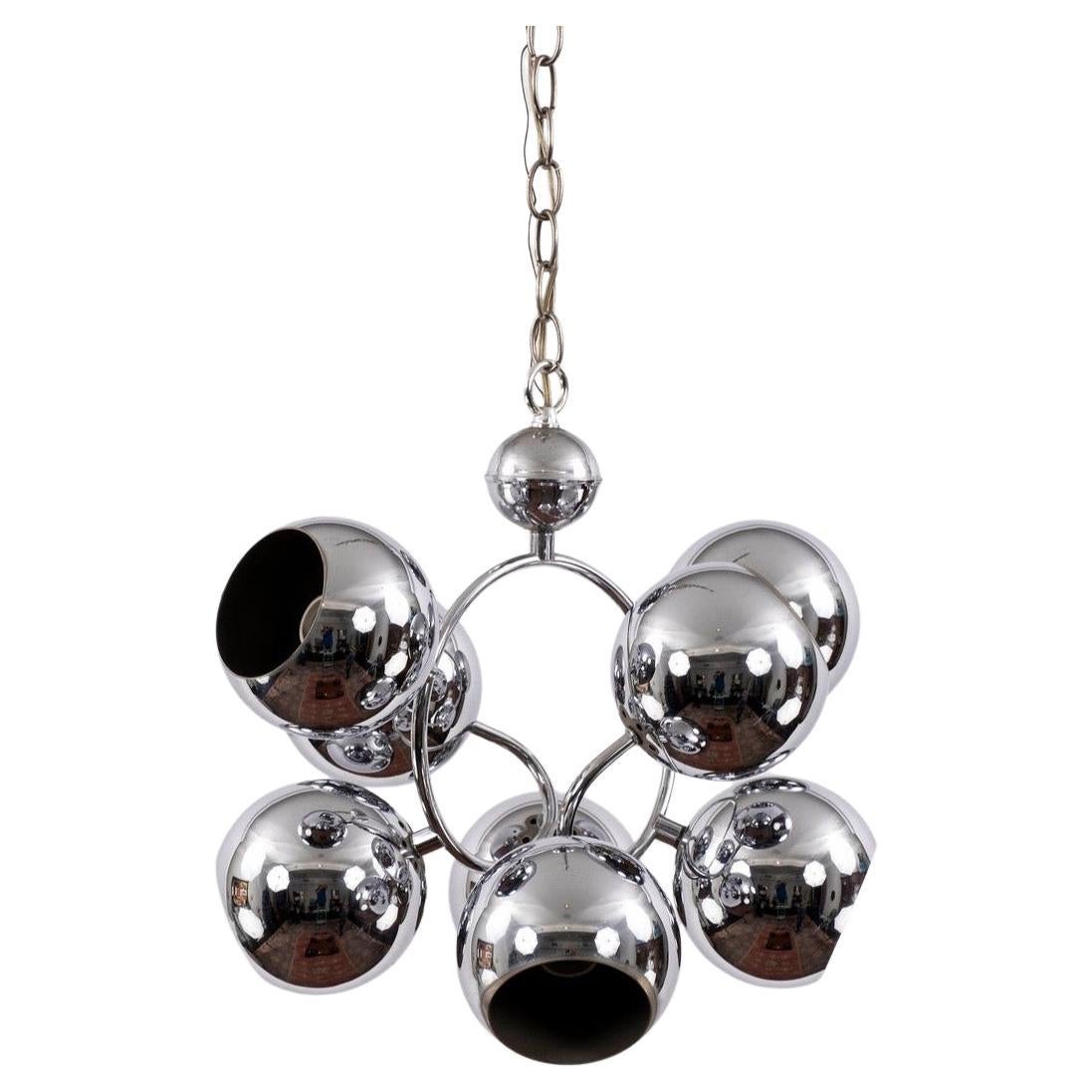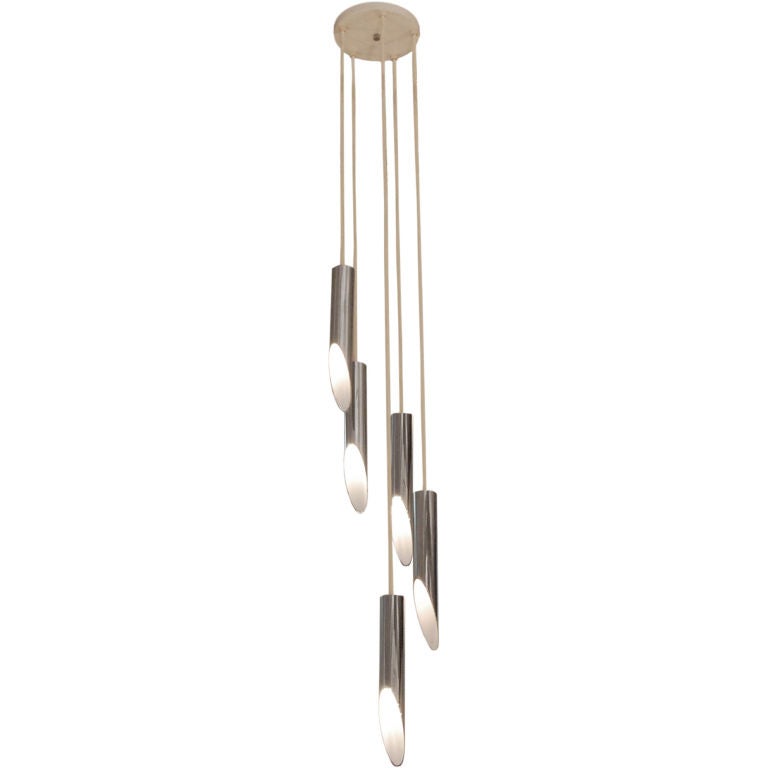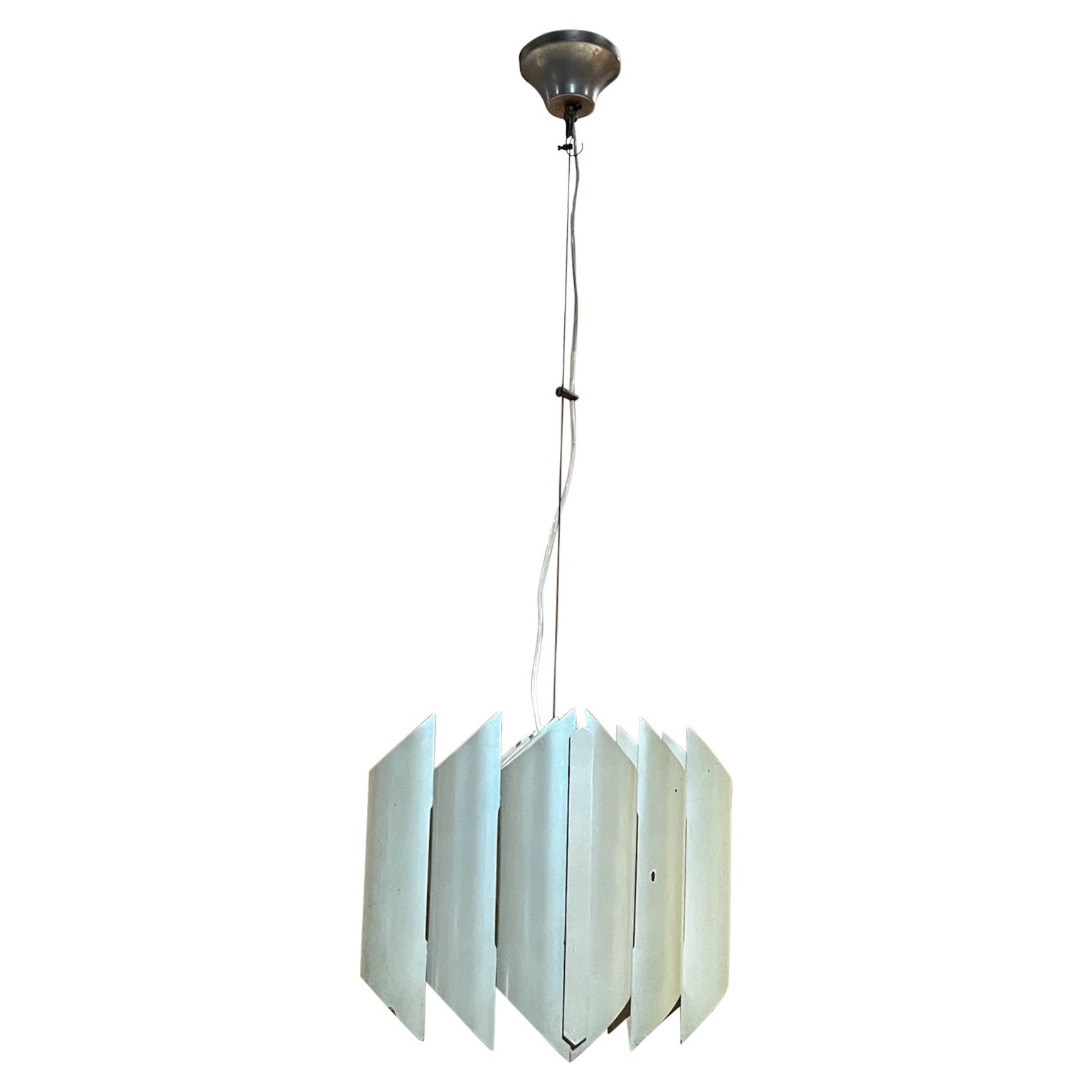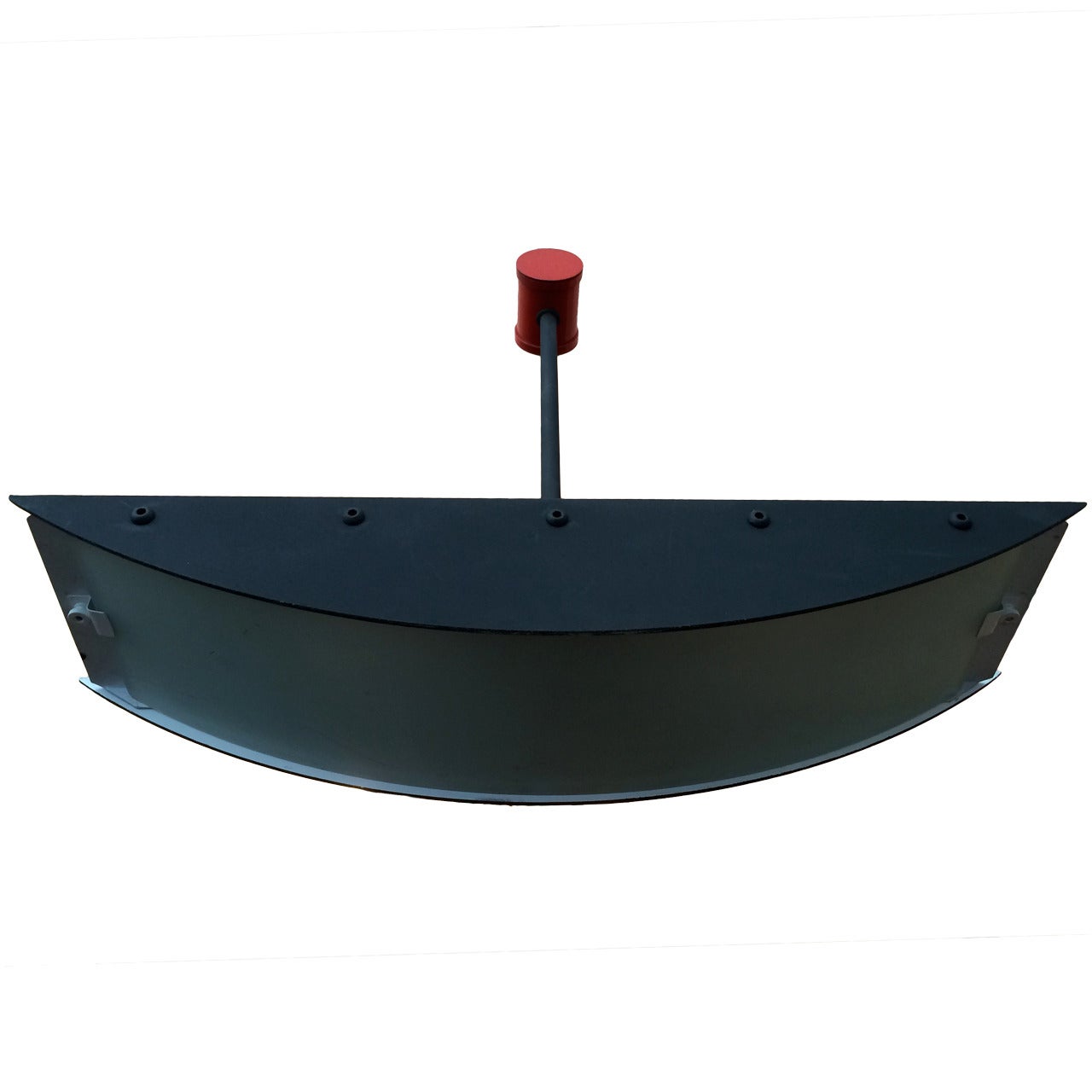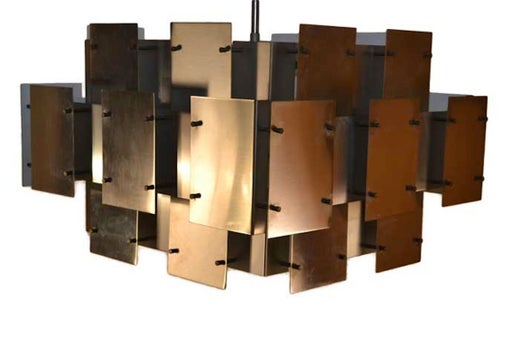Robert Sonneman Cascading Pendant Chandelier
About the Item
- Creator:Robert Sonneman (Manufacturer, Designer)
- Dimensions:Height: 39.5 in (100.33 cm)Diameter: 12.5 in (31.75 cm)
- Style:Mid-Century Modern (Of the Period)
- Materials and Techniques:
- Place of Origin:
- Period:
- Date of Manufacture:1970s
- Condition:Wear consistent with age and use. Faint scratches here and there.
- Seller Location:Los Angeles, CA
- Reference Number:1stDibs: LU4655217935982
Robert Sonneman
Though Robert Sonneman was quite literally born into the lighting business, it took working for another celebrated lighting maker for him to land upon the kind of boundary-pushing modernism for which the New York–based designer is known today.
At the age of 19, fresh off a stint in the U.S. Navy, Sonneman responded to an ad for a position working in the studio of George Kovacs on Manhattan’s Upper East Side, where he became the sole employee. “Although my parents were in the lighting business, they came from a traditional perspective, and Kovacs introduced me to modernism,” Sonneman once said. “It was 1961, and I was immediately captured by the movement.”
While working for Kovacs, Sonneman became captivated by the work of the Bauhaus, and he began experimenting with the influential art and design school’s ideas of functional simplicity in lighting. In 1967, he opened his own studio.
Though Sonneman Design Group produced furniture for a brief time, the designer eventually elected to focus on the one category that had always fascinated him; the brand became known for its floor lamps, sconces, pendants and chandeliers that feature unconventional treatments toward shape and balance, often inspired by modern architecture. Sonneman once said of his work: “I saw the lamps that I built as lighting machines that glorified the industrial aesthetic.”
Indeed, in the spirit of Bauhaus functionality — Sonneman has also cited Mies van der Rohe as being an inspiration — the designer’s work takes function-centric forms and motifs and elevates them while prioritizing technology. This spirit of forward thinking continues today, as Sonneman’s brand, renamed SONNEMAN – A Way of Light in 2003, works with LED bulbs to continue to push the boundaries of what functional lighting can achieve aesthetically.
Current-day releases by SONNEMAN – A Way of Light (still overseen by Sonneman himself) feature 95 percent LED lights and include interior and exterior lighting as well as modular suspended lights as an alternative to track lighting. Sonneman’s vintage pieces, however, are still widely collected on the secondary market.
Find vintage Robert Sonneman lighting on 1stDibs.
- ShippingRetrieving quote...Ships From: Los Angeles, CA
- Return PolicyA return for this item may be initiated within 3 days of delivery.
- 1940s Italian Venetian Murano Glass ChandelierBy Murano 5Located in Los Angeles, CAItalian Venetian Murano 1940s style (modern) clear glass chandelier with six fluted scroll arms supporting a large bowl with large 6 glass feathers emanating from a centre shaft with...Category
Mid-20th Century Italian Art Deco Chandeliers and Pendants
MaterialsMetal
- Casa Devall Sunburst Wall SculptureBy Casa DevallLocated in Los Angeles, CASunburst wall sculpture with a hammered brass center and two layers of painted rods creating a sunburst effect. The artist hand signed the sculpture on the verso.Category
Vintage 1970s American Mid-Century Modern Wall-mounted Sculptures
MaterialsBrass
- Birds in Flight off Coast Sculpture on Onyx Stone by Curtis JereBy Curtis JeréLocated in Los Angeles, CASigned brass sea gull sculpture by Curtis Jere. C Jere’ works are made and marketed by the corporation Artisan House. Curtis Jere is a compound nom de plume of artists Curtis Freiler...Category
Late 20th Century American Mid-Century Modern Figurative Sculptures
MaterialsOnyx, Brass
- Vintage Italian Murano Glass Sconces by MazzegaBy MazzegaLocated in Los Angeles, CAA pair of Vintage Italian Murano glass sconces by Mazzega. Each piece of glass is had blown into a thick oval shape. There are ...Category
Vintage 1950s Italian Mid-Century Modern Wall Lights and Sconces
MaterialsSteel
- Karate chair, Michel Cadestin for AirborneBy Michel CadestinLocated in Los Angeles, CAThis iconic chair is designed by Michel Cadestin for French furniture manufacturer Airborne, circa 1970s. This lounge chair, referred to as the "Karate" chair, is made of white mold...Category
Vintage 1970s French Mid-Century Modern Lounge Chairs
MaterialsFiberglass
- Leslie Diamond for Conant Ball Midcentury Set of Side TablesBy Leslie Diamond, Conant BallLocated in Los Angeles, CASolid maple side tables for Conant Ball by Leslie Diamond.Category
Vintage 1950s American Mid-Century Modern Side Tables
MaterialsWood
- Robert Sonneman Molecule ChandelierBy Robert SonnemanLocated in Houston, TXVintage 8 light Robert Sonneman chrome orb molecule chandelier.Category
Mid-20th Century North American Space Age Chandeliers and Pendants
MaterialsChrome
- Robert Sonneman "Cityscape" Brutalist ChandelierBy Robert SonnemanLocated in New York, NYModernist sheet steel and brass fixture, by Robert Sonneman. Large and impressive.Category
Vintage 1970s American Brutalist Chandeliers and Pendants
- Chandelier with Five Chrome Pendant Lights by Robert SonnemanBy Robert SonnemanLocated in New York, NYChandelier with five chrome pendant lights by Robert Sonneman, American, 1970s. The drops of each pendant can be adjusted.Category
Vintage 1970s American Chandeliers and Pendants
- Robert Sonneman "High Style" Brass ChandelierBy Robert SonnemanLocated in New York, NYA rare Robert Sonneman brass sculptural pendant chandelier.Category
Vintage 1970s American Mid-Century Modern Chandeliers and Pendants
MaterialsBrass
- 1970s Tubular Pearl Metal Sheet Cathedral Chandelier Pendant Robert SonnemanBy Robert SonnemanLocated in Chula Vista, CA1970s, Tube cathedral chandelier pendant by Robert Sonneman. Modern sheets of mother-of-pearl metal form tubes on this sculptural modern art chan...Category
Vintage 1970s American Mid-Century Modern Chandeliers and Pendants
MaterialsMetal, Aluminum
- Robert Sonneman 1980s "Art Tech" PendantBy Robert SonnemanLocated in New York, NYA New York 1980s "Art-tech" ceiling light by famed lighting designer, Robert Sonneman. Original label. Rewired. Bio: Robert launched his own lighting company under the Sonneman brand in 1967. His products were featured in retailers such as Bloomingdales, Macys and many others. In 1974 Robert founded Sonneman Design Group developing products for leading brands for the home including, Lightolier, Sunbeam Appliance, Singer, Stanley Furniture, Brueton, Goody Products, Lifetime Brands and others. Since 1967 Robert's work has been displayed by the Museum of Modern Art, Chicago Art Institute, Cooper-Hewitt National Design Museum, UCLA Exhibition on Design, Karnette County Art Museum and the Houston Contemporary Arts Museum. Robert has participated and lectured at Stanford University, Pratt School of Architecture, Parsons School of Design, Philadelphia College of Art and UCLA. He was also a contributor on Chrysler and Toyota projects at the Art Center, Pasadena College of Design, and served on the Nissan Design Advisory Board. In 1990, Sonneman again broke new ground for Stanley Furniture with his "Urban Primitive" collection for Macy's, a comprehensive program of home furnishings. From 1999 to 2005 Robert served as president and CEO of Ralph Lauren Home Product Development. In 2003 with partners David Littman and Sonny Park, Robert founded Sonneman - A Way of Light. Robert Sonneman pioneered modern lighting making it an art form. World renowned and acclaimed for clean lines and alliance to form and function, his world famous award winning designs have been at the forefront of the design world for over four decades. Robert introduced sleek, new functionalist lighting...Category
Late 20th Century American Mid-Century Modern Chandeliers and Pendants
MaterialsSteel
